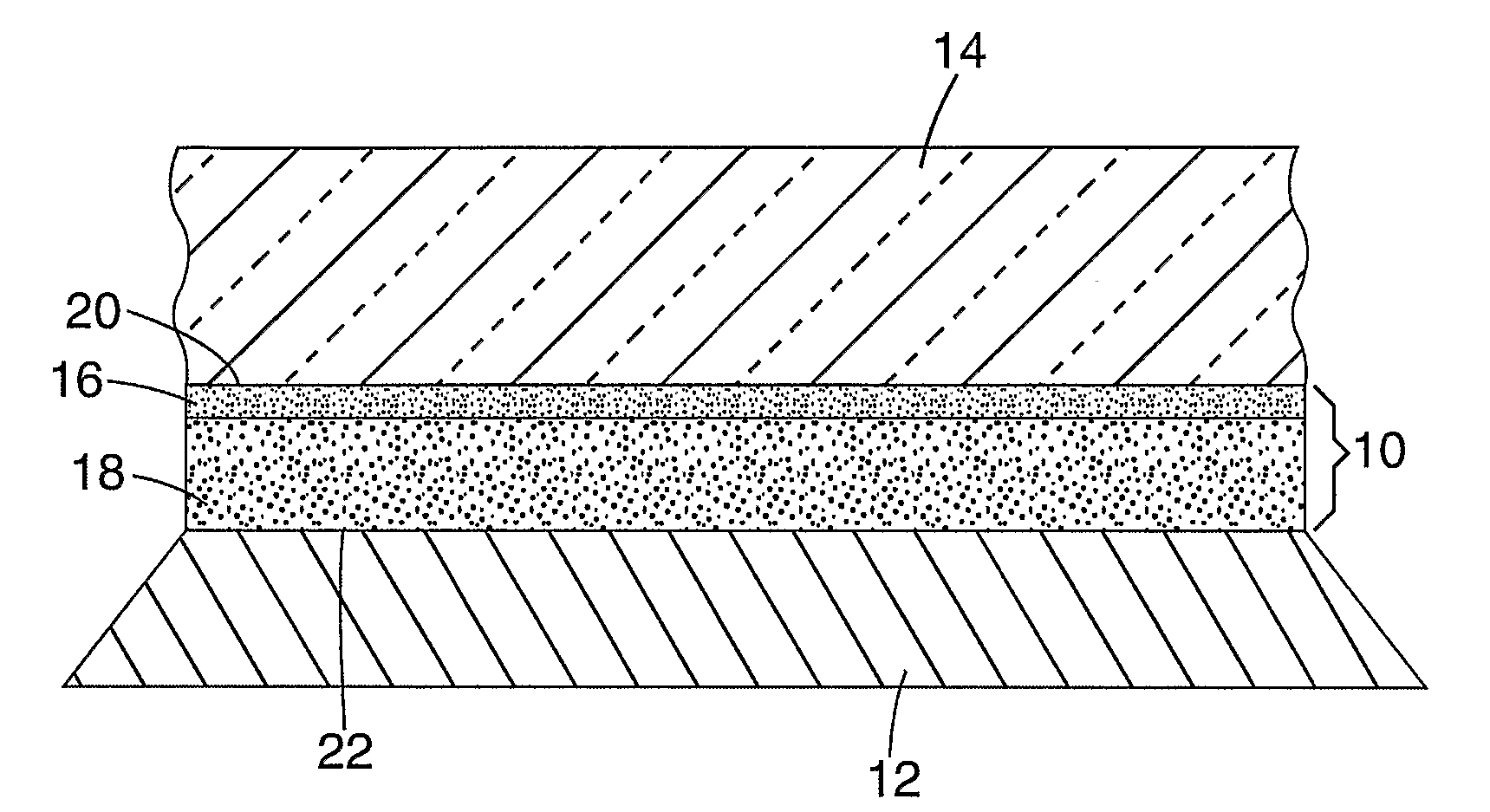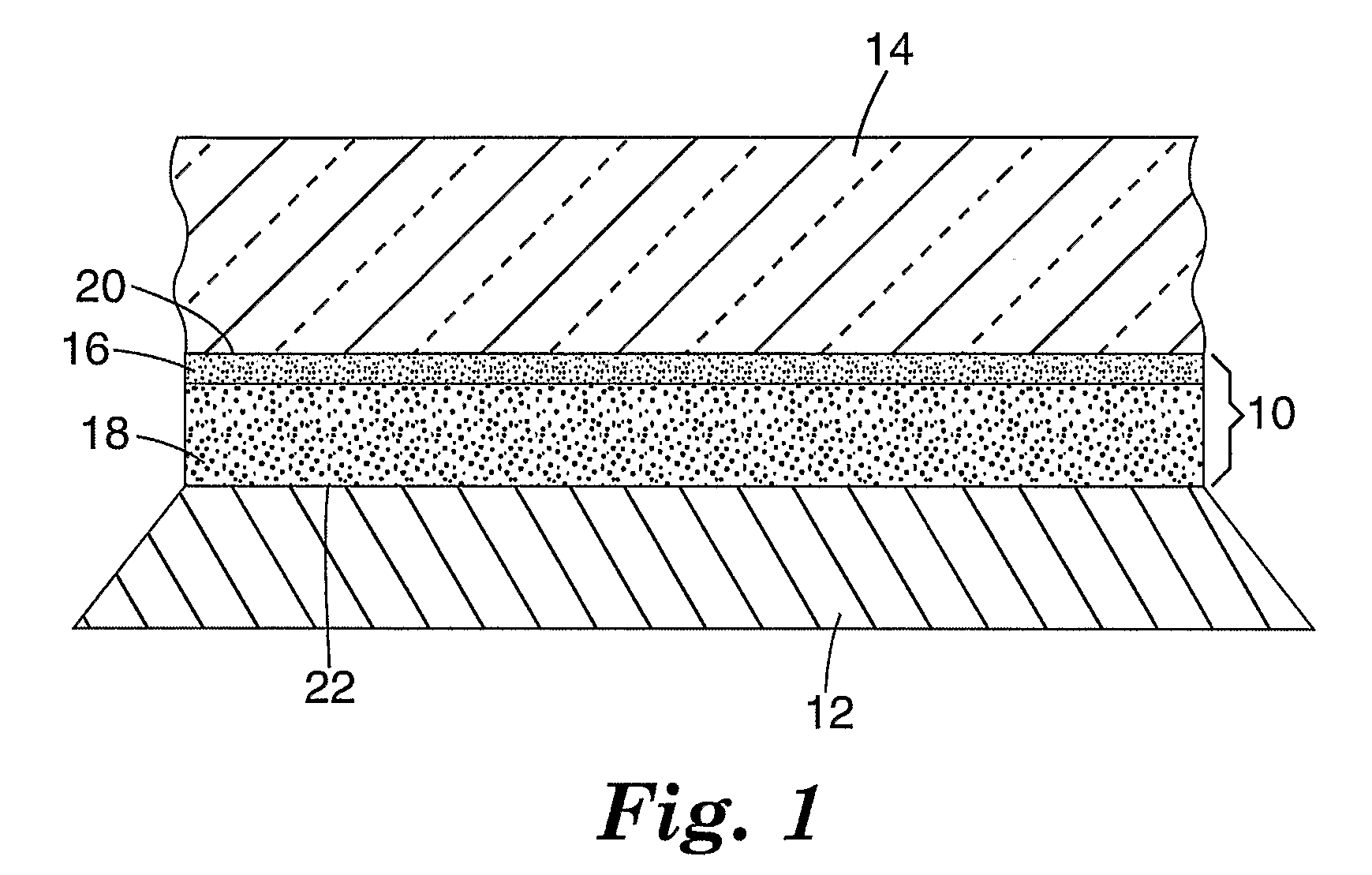Thermosettable Adhesive Tape, Articles And Methods
- Summary
- Abstract
- Description
- Claims
- Application Information
AI Technical Summary
Benefits of technology
Problems solved by technology
Method used
Image
Examples
examples
Base Solution for Example 1 and 6
[0024]A premix composition was prepared by mixing 75 parts of n-butyl acrylate, 25 parts of N vinyl caprolactam, and 0.04 parts of photoinitiator (alpha,alpha-dimethoxy-alpha-phenylacetophenone available under the tradename Irgacure 651 from Ciba Specialty Chemicals Corporation, Tarrytown N.Y.) and exposing to ultraviolet black lamps to form a syrup having a viscosity of about 1500 cps.
[0025]An adhesive composition was prepared by mixing 42.6 parts of the premix composition, 3.2 parts of 2-hydroxy-3-phenoxy propyl acrylate, 29.8 parts of liquid epoxy resin (bisphenol-A epichlorhydrin available under the tradename Epon 828 from Resolution Performance Products LLC, Houston, Tex.) and 16.0 parts of solid epoxy (Epon 1101F) resin (phenol, 4,4′-(1-methylethylidene) bis-, polymer with 2,2′-((1-methylethylidene) bis(4,1-phenylene oxymethylene)) bis(oxirane) with a propellor mixer set at high speed for 30 minutes while heating to about 49° C. to form a unifo...
examples 7-13
[0042]Tapes for Examples 7-13 were prepared according to the procedure for the base solution for examples 2, 3, 4, 5 except that the accelerator used was micronized 2MZ-Azine, and the amounts of the carbon black dispersion (Pennco 9B117) were 0.23%, 1.5%, 2.5%, and 3.5% based on the total weight of the composition, and coated in thicknesses of 5 mils and 25 mils. The pigment content, i.e., only the carbon black, is shown in Table 2 also included is the first layer thickness, acrylic cure success, color evaluation, and torque testing. Tapes having a thickness of 25 mils were tested without laminating to another layer of adhesive. The 5 mil tapes were laminated to a 20 mil thick 9214 Structural Bonding Tape. When bonding these two layer samples to glass the first layer (thinner / more pigment) is attached to the glass, the second layer (thicker / less pigment) is attached to the mirror button.
[0043]25 mil tapes in Examples 11 and 13 exhibited incomplete acrylic cure and were not be tested...
examples 14-19
[0044]Solutions and tapes were prepared for Examples 14-19 according to the procedure for the base solution of 2, 3, 4, 5 except that the pigment dispersions amounts were either 2.8% (0.42% carbon black) or 3.8% (0.57% carbon black). The target thicknesses were 5, 8, and 10 mils for each pigment amount although the actual thicknesses were higher as shown in Table 3. Tapes were prepared by laminating to 9214 Structural Bonding Tape and tested for torque and cleavage with results shown in Table 3. All of the tapes were essentially black in color.
TABLE 3Torque (foot-PigmentThickness (mils)pounds) / FailureCleavageExcontent (%)target / actualMode(pounds)140.425 / 7 36.7 / TFG* 185 / C**150.428 / 9 33 / TFG161 / C160.4210 / 1236.4 / TFG156 / C170.575 / 736.7 / TFG137 / C180.578 / 938.5 / TFG133 / C190.5710 / 12 25 / TFG101 / C*“TFG” = thin film remaining on glass. Majority of adhesive remaining on mirror button.**“C” = Cohesive failure mode (e.g., 185 / C = 185 pounds of force with Cohesive failure.
TABLE 3-AExL* speular exclud...
PUM
| Property | Measurement | Unit |
|---|---|---|
| Fraction | aaaaa | aaaaa |
| Percent by mass | aaaaa | aaaaa |
| Percent by mass | aaaaa | aaaaa |
Abstract
Description
Claims
Application Information
 Login to View More
Login to View More - Generate Ideas
- Intellectual Property
- Life Sciences
- Materials
- Tech Scout
- Unparalleled Data Quality
- Higher Quality Content
- 60% Fewer Hallucinations
Browse by: Latest US Patents, China's latest patents, Technical Efficacy Thesaurus, Application Domain, Technology Topic, Popular Technical Reports.
© 2025 PatSnap. All rights reserved.Legal|Privacy policy|Modern Slavery Act Transparency Statement|Sitemap|About US| Contact US: help@patsnap.com


